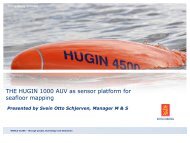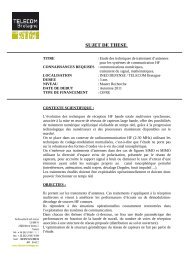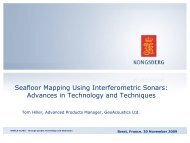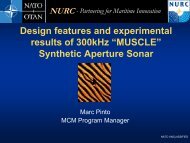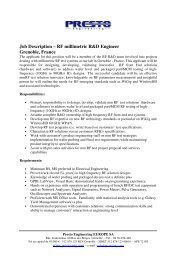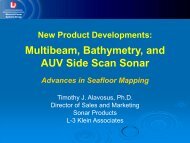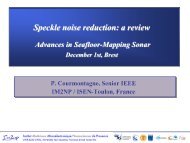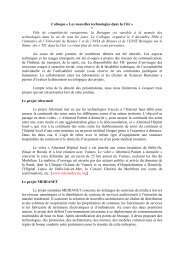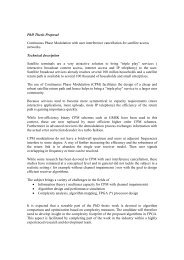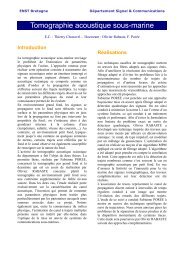Département Réseau, Sécurité et Multimédia Rapport d'Activités 2008
Département Réseau, Sécurité et Multimédia Rapport d'Activités 2008
Département Réseau, Sécurité et Multimédia Rapport d'Activités 2008
You also want an ePaper? Increase the reach of your titles
YUMPU automatically turns print PDFs into web optimized ePapers that Google loves.
R<strong>et</strong>hought Mobility Management in Future Multi-technologiesAccess N<strong>et</strong>worksResearch Staff : Xavier Lagrange, Jean-Marie Bonnin – Ph.D. Student: Philippe BertinKeywords : ambient n<strong>et</strong>works, mobile n<strong>et</strong>works, h<strong>et</strong>erogeneous access n<strong>et</strong>worksPartners & Funding : France Telecom Thesis with PracomDescriptionIn the near future, our n<strong>et</strong>work environmentwill be undoubtedly highly h<strong>et</strong>erogeneous interms of access technologies of course, butalso regarding the functional architecture. Asdifferent access n<strong>et</strong>works have beenstandardized by different organizations, theyoperate in ways which are based on differentassumptions and with a diversity ofoptimization goals and means.The aim of this work is to define a common(minimal) access n<strong>et</strong>work functionalarchitecture able to integrate different accesstechnologies coming from differentstandardization bodies. This architectureshould be able to benefit from mesh as well ascollaborative n<strong>et</strong>work to extend its coverage.The mobility management should take intoaccount resources and QoS management in an<strong>et</strong>work centric way to allow integratedoperators to offer a seamless service to itscustomer.AchievementsA state of the art on the fixed and mobileaccess n<strong>et</strong>work architecture have beenachieved. A list of essential functions we foundin the different architecture is on the way witha focus on those related to mobilitymanagement.s<strong>et</strong>up and maintain tunnels in the n<strong>et</strong>work foreach attached or active mobile node. Otheralternatives to tunneling where proposed someyears ago based on per-host routingapproaches (Cellular IP, Hawaii) but did notme<strong>et</strong> standards adoption y<strong>et</strong>. Per-host routinghas the advantage of being easily introducedin existing IP routing protocols withoutmodifications. We evaluated both approachesin a WLAN environment thanks to simulations.Results show that handover delay is negligiblyimpacted in our per-host scheme, whereas it isstrongly penalized in tunneling approaches.Future worksFor the following of the work, a multitechnologiesaccess architecture will beproposed. Its aim is to support neighboringbased connectivity management schemesb<strong>et</strong>ween Base Stations and Access Points fromdifferent technologies (e.g. 2G, WCDMA, LTE,Wimas, WiFi, any new 4/5G technology…). Weconsider that access n<strong>et</strong>work entities will bepart of the same access n<strong>et</strong>work in order toallow a given terminal and communication flowto make use of optimized connectivity adaptedto its own requirements. In this novelapproach, any new technology could be easilydeployed using the common n<strong>et</strong>workinfrastructure, architecture and protocols whileinter-technologies convergence mechanismsimpacts becomes negligible.A preliminary study has been compl<strong>et</strong>ed on theuse of host routing approaches to supportmobility management in pack<strong>et</strong> based wirelessn<strong>et</strong>works where it is generally realized withvarious tunneling protocols. Tunnelingapproaches requires specific mechanisms toPracom’s Annual Report <strong>2008</strong> 25



